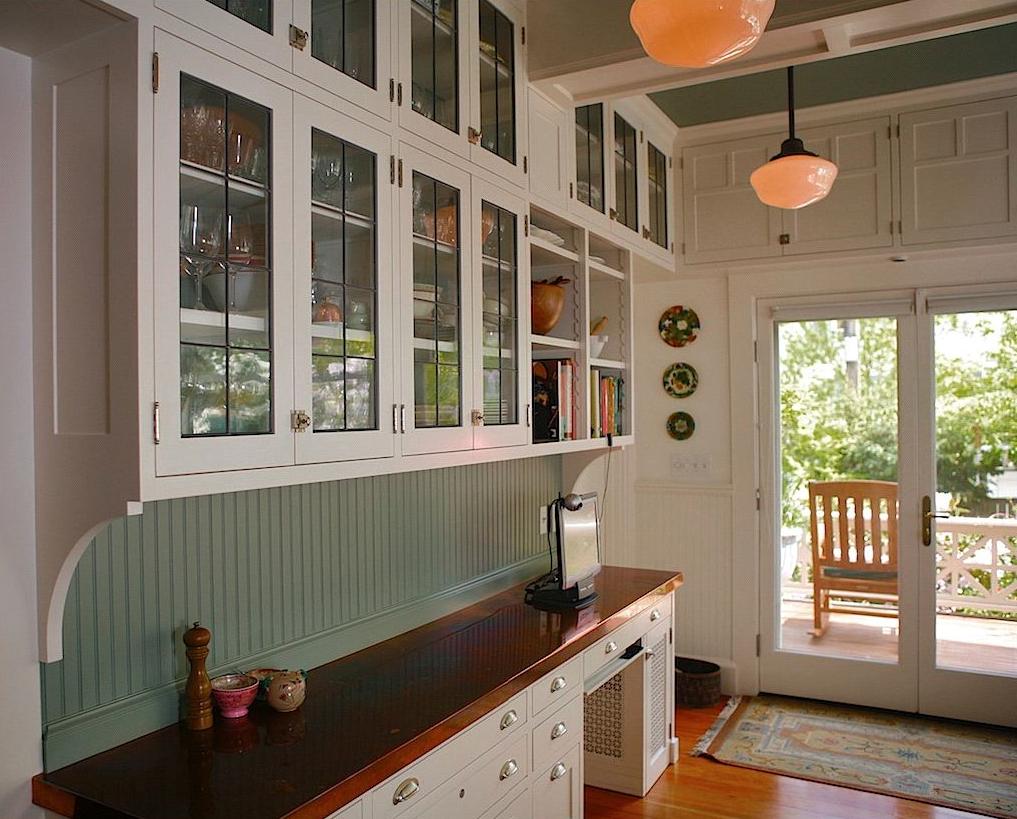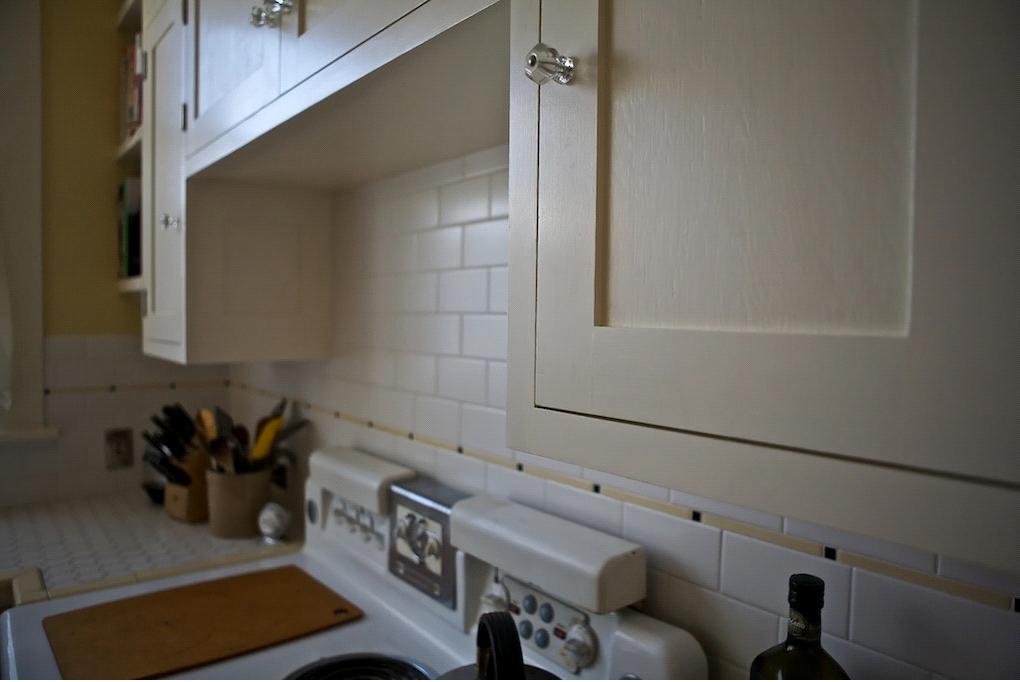Question
We build custom cabinets. Most of our work is kitchens. Over the years we have tended to trade at the upper end of our local market. We focus on architectural elements you might find in a house built in the 1920's, +/- a couple of decades. We are in the process of developing a lower cost offering. A typical project for us has a hand brushed finish (first coats are sprayed, last coat is brushed) with an oil based Benjamin Moore Satin Impervo. A local paint shop said that they could produce a relatively inexpensive white paint finish by using pigmented conversion varnish. I would like to learn what I can about this finish, mostly what to expect over time.
One of the reasons we prefer a brush finish is that it tends to mask wood movement that telegraphs through a sprayed finish. What can we expect to see, with respect to this wood movement, if we went with conversion varnish instead of brushed enamel? Are there any durability issues we need to be aware of? How easy is conversion varnish to repair if the need should arise in the future? Our typical customer for this new product line might be a do-it-yourselfer. Could they reasonably expect to repair or touch up this work themselves?
If I am missing anything else please educate me. I am really quite unsure when it comes to finish and would like to hear from professionals about this. Are there any other pros or cons I should be aware of with pigmented conversion varnish?
Forum Responses
(Finishing Forum)
From contributor M:
You wrote: “we are in the process of developing a lower cost offering.” Not sure how brushing the last coat will save money? Time is money and brushing takes longer than spraying. It would be easier to do touchups on site, or six months from now. I’m not sure why you are worried about wood movement - are you using five piece doors? Switch to MDF doors and frameless cabinets.
1. How does any finish mask wood movement? I don't understand what you're asking.
2. CV is much more durable than any enamel and it will not yellow like enamel.
3. CV is not that easy to repair as the new finish doesn't melt into the prior coat but it can be repaired.
4. By and large CV is a very good wood finish with outstanding characteristics. I've never considered it a cost saver.
It is difficult to repair conversion varnish. It can be done successfully by a professional with access to professional products but it is not by any stretch a DIY repair job. Wood movement will not be masked with conversion varnish. Excessive movement may cause cracking of the coating. Conversion varnish dry times for sanding and recoating will be faster than your current coating. In service dry times are similar with both being about 24+ hours. This is without forced air drying.
According to your description I would highly recommend looking into the Muralo Ultra waterbourne line of products for your needs. Muralo has interesting chemical properties. In layman terms it is a hydrophobic waterbourne. So while water is the carrier of the resin, the molecular make up being hydrophobic throws off the water quickly so it tends to dry to touch and handle faster than most waterbournes. Painting in a high RH condition would extend the drying time somewhat.
Muralo Ultra has excellent durability, stain and water resistance. It can be tinted to any light colored Ben Moore color. It is very easy to touch up and a DIY'r can successfully touch it up as well as a professional would with some of the left over matching paint, sandpaper and a brush, roller or whatever depending on the size and location of the damage. It will not yellow over time the way your current oil based will.
It sprays, rolls and brushes beautifully. It lays out and levels like a dream. If you want the brushed look you will have to back brush a painted area after about 3-5 minutes of drying. Dry film build is up to 3 mils.
Dry to handle time is 2-4 hours. Recoat time is 4-6 hours. In service time would technically be 24 plus hours but I always recommend that caution be taken for 30 days and no harsh cleaning chemicals be used during that time. I am guessing that if you employ the brushed look then you would get some wood movement masking but this would be more of a fool the eye effect as it won't bridge over any significant movement without breaking the line. I have never actually run a test on this so I cannot truthfully quantify this for you.
Cost should be about $30 per gallon with the 25-30% discount you should be able to receive as a professional. Depending on where you are located there may not be a dealer close by. Muralo headquarters is in NJ. Are you looking to do the painting in your own facility or do you plan on farming it out?

Here is an example of the "aging" we are trying to introduce to our work.

It was the on location kitchen paint jobs that led me to look for and find the Muralo Ultra product. I used to do even on location work in conversion varnish, but not anymore, I leave CV for new in the shop only clear coat finishing.
Muralo Ultra has close to zero olfactory smell. This doesn't mean that there are no fumes as even water based coatings contain chemistry that you should protect your workers from, but the exposure vs. voc coatings is drastically less significant as is the cost of cleanup. A client can actually cook in their kitchen every evening during the renovation albeit carefully and it's a no fry zone until the project is complete and paid for.
I can't really see the aging you are referring to in the image other than a slight hint of brush marks on the center panel I think I am picking up. You can get any level of brush marks you are after with Muralo Ultra but you do have to make it happen with JIT back brushing because left to its own it wants to lay out like a sprayed finish even if you brushed it on. You can get a nice effect when you stop at two coats which lets just a hint of the wood grain show through. Three coats will fill even oak.
I absolutely love the stuff as I'm sure you can tell. I am a high end market finisher who has worked with a lot of different coatings over the years. With this product I can make a nasty 1980's oak Merrilat kitchen look like they spent gobs of money and I have been very profitable doing it. Ultra Satin just has a je ne sais quoi expensive look to it. On new cabinetry I would expect that you would see some profitable benefits by switching to this product on top of the customer satisfaction.
You didn't say where you are located and as I said some people have had trouble finding a distributor but even if you have to have it trucked in it is worth it in my opinion. Until recently I was in Chicago and I had multiple distributors available to me so I never had to deal with that problem.
Now it does have its tricks and learning curve but with a little up front info on what the tricks are and a few hours over a few days of playing with it on samples your finisher can get it down pat and will not want to ever turn back.
If you are going to want to do this in your own shop let me know and I can provide a complete finishing schedule for you. If another shop will be doing it for you they will have their own ways they'll want to use. I hope that helps.
Contributor S, I would disagree with your dry mil thickness comments. CV is often rated up 5 mil, which is very thin as far as finishes go. It is brittle. BM Impervo is an oil-based alkyd house paint that is flexible. Muralo Ultra is a WB acrylic house paint that is likewise flexible. Please direct me towards you info on dry mil of those products.
I've personally never done more than three coats of Muralo for maybe a total of 4 mils dft, but I've seen others pile it on much heavier and never heard of a failure coming back at them caused by mil thickness. I've never used BM oil Impervo so I can't relay any experience. I always follow the mfg. recommendations for CV, have never had to exceed the recommended dft and as such have never had a failure, but I know others who have and it bit them.